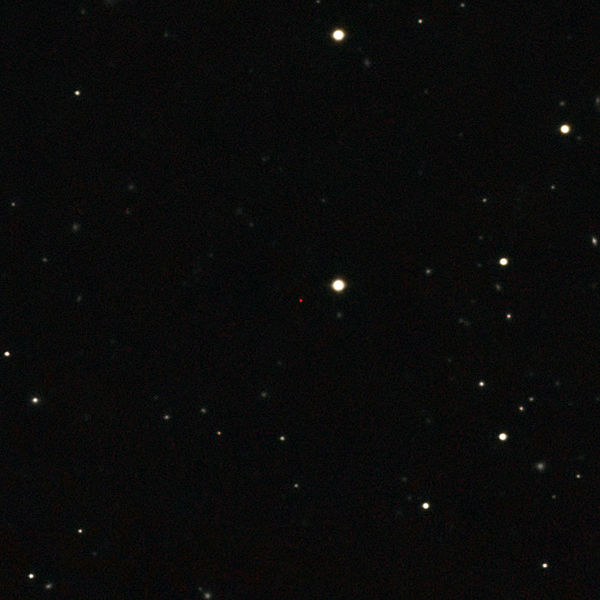File:ULAS J1120+0641.jpg
维基共享资源,媒体文件资料库
跳转到导航
跳转到搜索

本预览的尺寸:600 × 600像素。 其他分辨率:240 × 240像素 | 480 × 480像素 | 768 × 768像素 | 1,024 × 1,024像素 | 1,298 × 1,298像素。
原始文件 (1,298 × 1,298像素,文件大小:421 KB,MIME类型:image/jpeg)
文件信息
结构化数据
说明
说明
添加一行文字以描述该文件所表现的内容
摘要
[编辑]| 描述ULAS J1120+0641.jpg |
English: This image of ULAS J1120+0641, a very distant quasar powered by a black hole with a mass two billion times that of the Sun, was created from images taken from surveys made by both the Sloan Digital Sky Survey and the UKIRT Infrared Deep Sky Survey. The quasar appears as a faint red dot close to the centre. This quasar is the most distant yet found and is seen as it was just 770 million years after the Big Bang. |
| 日期 | |
| 来源 | http://www.eso.org/public/images/eso1122b/ |
| 作者 | ESO/UKIDSS/SDSS |
许可协议
[编辑]本文件采用知识共享署名 3.0 未本地化版本许可协议授权。
- 您可以自由地:
- 共享 – 复制、发行并传播本作品
- 修改 – 改编作品
- 惟须遵守下列条件:
- 署名 – 您必须对作品进行署名,提供授权条款的链接,并说明是否对原始内容进行了更改。您可以用任何合理的方式来署名,但不得以任何方式表明许可人认可您或您的使用。
| 註解 InfoField | 該圖片含有註解:在維基媒體共享資源上查看註解 |
621
623
61
52
1298
1298
ULAS J1120+0641
文件历史
点击某个日期/时间查看对应时刻的文件。
| 日期/时间 | 缩略图 | 大小 | 用户 | 备注 | |
|---|---|---|---|---|---|
| 当前 | 2011年7月4日 (一) 14:03 |  | 1,298 × 1,298(421 KB) | Jmencisom(留言 | 贡献) |
您不可以覆盖此文件。
文件用途
以下页面使用本文件:
全域文件用途
以下其他wiki使用此文件:
- ar.wikipedia.org上的用途
- de.wikipedia.org上的用途
- el.wikipedia.org上的用途
- en.wikipedia.org上的用途
- en.wikiversity.org上的用途
- es.wikipedia.org上的用途
- fi.wikipedia.org上的用途
- fr.wikipedia.org上的用途
- id.wikipedia.org上的用途
- it.wikipedia.org上的用途
- ja.wikipedia.org上的用途
- ko.wikipedia.org上的用途
- ml.wikipedia.org上的用途
- my.wikipedia.org上的用途
- pl.wikipedia.org上的用途
- ru.wikipedia.org上的用途
- simple.wikipedia.org上的用途
- sv.wikipedia.org上的用途
- vi.wikipedia.org上的用途
- www.wikidata.org上的用途
- zh.wikipedia.org上的用途
元数据
此文件含有额外信息,这些信息可能是创建或数字化该文件时使用的数码相机或扫描仪所添加的。如果文件已从其原始状态修改,某些详细信息可能无法完全反映修改后的文件。
| 图像标题 | This image of ULAS J1120+0641, a very distant quasar powered by a black hole with a mass two billion times that of the Sun, was created from images taken from surveys made by both the Sloan Digital Sky Survey and the UKIRT Infrared Deep Sky Survey. The quasar appears as a faint red dot close to the centre. This quasar is the most distant yet found and is seen as it was just 770 million years after the Big Bang. |
|---|